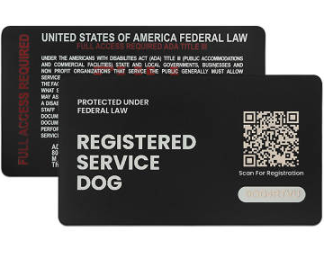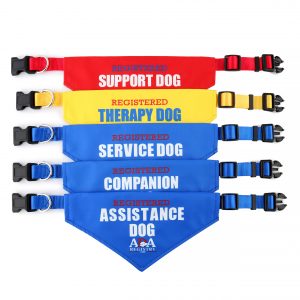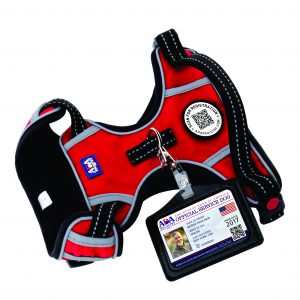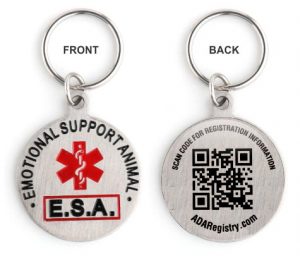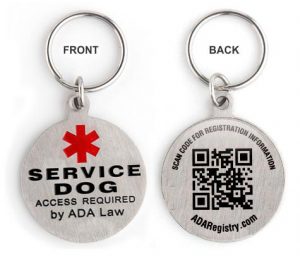Memphis loki barnett
Hi I’m memphis. I love my family. I go to work everyday and love to see people and make them happy. Im a good boy and just wanna have fun
Police Search for Stolen Emotional Support Dog
A woman moved to the Bay Area and while looking for a place to live, had her rental car stolen. But the bigger problem was — her dog was inside. Ian Cull reports.
Suva’s Profile Picture
Souvenir (Suva), Female, Spayed, Senior, Standard Poodle, Color: silver beige, Status: semi-retired, Tasks: counter-balance, medical response
Franky posing for a picture
This is Franky posing for a picture. He is a Deer Head Chihuahua. He weighs 4.5 pounds and he is tan in color with a white streak that starts on his forehead and ends at his tail. His chest is white and he has white circles around his eyes.
Ari posing cutie
Ari is friendly, well behave in restaurant patios and around people. Does not get distracted or go after other dogs, prefers to be near her parents.
Buddy always there when I need him.
Buddy, relaxing without his harness. Greatest service dog ever, at least to me. He is always there to help, don’t think I could get through a day without him.
Full Body Picture of Stetson Just Prior to a Therapy Visit
This is a photo of Stetson bathed and brushed and ready to make a 2-hour visit at the senior facility he visits every week. He typically visits for 2 to 2 1/2 hours and visits Independent, Assisted and Memory Care Villages.
Therapy Visit with a Resident at a Senior Facility
This is one of many photos of Stetson on a therapy visit. Residents hold him, pet him, brush him, hug him, kiss on him. He has been visiting facilities since he was only 4 months old.
TOP 37 Questions About Service Dogs Answered By The ADA
Frequently Asked Questions about Service Animals and the ADA
Many people with disabilities use a service animal in order to fully participate in everyday life. Dogs can be trained to perform many important tasks to assist people with disabilities, such as providing stability for a person who has difficulty walking, picking up items for a person who uses a wheelchair, preventing a child with autism from wandering away, or alerting a person who has hearing loss when someone is approaching from behind.
The Department of Justice continues to receive many questions about how the Americans with Disabilities Act (ADA) applies to service animals. The ADA requires State and local government agencies, businesses, and non-profit organizations (covered entities) that provide goods or services to the public to make “reasonable modifications” in their policies, practices, or procedures when necessary to accommodate people with disabilities. The service animal rules fall under this general principle. Accordingly, entities that have a “no pets” policy generally must modify the policy to allow service animals into their facilities. This publication provides guidance on the ADA’s service animal provisions and should be read in conjunction with the publication ADA Revised Requirements: Service Animals.
Definition | General Rules | Certification and Registration
Breeds | Exclusion of Service Animals | Miscellaneous | Resources
DEFINITION OF A SERVICE ANIMAL
Q1. What is a service animal?
A. Under the ADA, a service animal is defined as a dog that has been individually trained to do work or perform tasks for an individual with a disability. The task(s) performed by the dog must be directly related to the person’s disability.
Q2. What does “do work or perform tasks” mean?
A. The dog must be trained to take a specific action when needed to assist the person with a disability. For example, a person with diabetes may have a dog that is trained to alert him when his blood sugar reaches high or low levels. A person with depression may have a dog that is trained to remind her to take her medication. Or, a person who has epilepsy may have a dog that is trained to detect the onset of a seizure and then help the person remain safe during the seizure.
Q3. Are emotional support, therapy, comfort, or companion animals considered service animals under the ADA?
A. No. These terms are used to describe animals that provide comfort just by being with a person. Because they have not been trained to perform a specific job or task, they do not qualify as service animals under the ADA. However, some State or local governments have laws that allow people to take emotional support animals into public places. You may check with your State and local government agencies to find out about these laws.
Q4. If someone’s dog calms them when having an anxiety attack, does this qualify it as a service animal?
A. It depends. The ADA makes a distinction between psychiatric service animals and emotional support animals. If the dog has been trained to sense that an anxiety attack is about to happen and take a specific action to help avoid the attack or lessen its impact, that would qualify as a service animal. However, if the dog’s mere presence provides comfort, that would not be considered a service animal under the ADA.
Q5. Does the ADA require service animals to be professionally trained?
A. No. People with disabilities have the right to train the dog themselves and are not required to use a professional service dog training program.
Q6. Are service-animals-in-training considered service animals under the ADA?
A. No. Under the ADA, the dog must already be trained before it can be taken into public places. However, some State or local laws cover animals that are still in training.
GENERAL RULES
Q7. What questions can a covered entity’s employees ask to determine if a dog is a service animal?
A. In situations where it is not obvious that the dog is a service animal, staff may ask only two specific questions: (1) is the dog a service animal required because of a disability? and (2) what work or task has the dog been trained to perform? Staff are not allowed to request any documentation for the dog, require that the dog demonstrate its task, or inquire about the nature of the person’s disability.
Q8. Do service animals have to wear a vest or patch or special harness identifying them as service animals?
A. No. The ADA does not require service animals to wear a vest, ID tag, or specific harness.
Q9. Who is responsible for the care and supervision of a service animal?
A. The handler is responsible for caring for and supervising the service animal, which includes toileting, feeding, and grooming and veterinary care. Covered entities are not obligated to supervise or otherwise care for a service animal.
Q10. Can a person bring a service animal with them as they go through a salad bar or other self-service food lines?
A. Yes. Service animals must be allowed to accompany their handlers to and through self-service food lines. Similarly, service animals may not be prohibited from communal food preparation areas, such as are commonly found in shelters or dormitories.
Q11. Can hotels assign designated rooms for guests with service animals, out of consideration for other guests?
A. No. A guest with a disability who uses a service animal must be provided the same opportunity to reserve any available room at the hotel as other guests without disabilities. They may not be restricted to “pet-friendly” rooms.
Q12. Can hotels charge a cleaning fee for guests who have service animals?
No. Hotels are not permitted to charge guests for cleaning the hair or dander shed by a service animal. However, if a guest’s service animal causes damages to a guest room, a hotel is permitted to charge the same fee for damages as charged to other guests.
Q13. Can people bring more than one service animal into a public place?
A. Generally, yes. Some people with disabilities may use more than one service animal to perform different tasks. For example, a person who has a visual disability and a seizure disorder may use one service animal to assist with way-finding and another that is trained as a seizure alert dog. Other people may need two service animals for the same task, such as a person who needs two dogs to assist him or her with stability when walking. Staff may ask the two permissible questions (See Question 7) about each of the dogs. If both dogs can be accommodated, both should be allowed in. In some circumstances, however, it may not be possible to accommodate more than one service animal. For example, in a crowded small restaurant, only one dog may be able to fit under the table. The only other place for the second dog would be in the aisle, which would block the space between tables. In this case, staff may request that one of the dogs be left outside.
Q14. Does a hospital have to allow an in-patient with a disability to keep a service animal in his or her room?
A. Generally, yes. Service animals must be allowed in patient rooms and anywhere else in the hospital the public and patients are allowed to go. They cannot be excluded on the grounds that staff can provide the same services.
Q15. What happens if a patient who uses a service animal is admitted to the hospital and is unable to care for or supervise their animal?
A. If the patient is not able to care for the service animal, the patient can make arrangements for a family member or friend to come to the hospital to provide these services, as it is always preferable that the service animal and its handler not be separated, or to keep the dog during the hospitalization. If the patient is unable to care for the dog and is unable to arrange for someone else to care for the dog, the hospital may place the dog in a boarding facility until the patient is released, or make other appropriate arrangements. However, the hospital must give the patient the opportunity to make arrangements for the dog’s care before taking such steps.
Q16. Must a service animal be allowed to ride in an ambulance with its handler?
A. Generally, yes. However, if the space in the ambulance is crowded and the dog’s presence would interfere with the emergency medical staff’s ability to treat the patient, staff should make other arrangements to have the dog transported to the hospital.
CERTIFICATION AND REGISTRATION
Q17. Does the ADA require that service animals be certified as service animals?
A. No. Covered entities may not require documentation, such as proof that the animal has been certified, trained, or licensed as a service animal, as a condition for entry.
There are individuals and organizations that sell service animal certification or registration documents online. These documents do not convey any rights under the ADA and the Department of Justice does not recognize them as proof that the dog is a service animal.
Q18. My city requires all dogs to be vaccinated. Does this apply to my service animal?
A. Yes. Individuals who have service animals are not exempt from local animal control or public health requirements.
Q19. My city requires all dogs to be registered and licensed. Does this apply to my service animal?
A. Yes. Service animals are subject to local dog licensing and registration requirements.
Q20. My city requires me to register my dog as a service animal. Is this legal under the ADA?
A. No. Mandatory registration of service animals is not permissible under the ADA. However, as stated above, service animals are subject to the same licensing and vaccination rules that are applied to all dogs.
Q21. My city / college offers a voluntary registry program for people with disabilities who use service animals and provides a special tag identifying the dogs as service animals. Is this legal under the ADA?
A. Yes. Colleges and other entities, such as local governments, may offer voluntary registries. Many communities maintain a voluntary registry that serves a public purpose, for example, to ensure that emergency staff know to look for service animals during an emergency evacuation process. Some offer a benefit, such as a reduced dog license fee, for individuals who register their service animals. Registries for purposes like this are permitted under the ADA. An entity may not, however, require that a dog be registered as a service animal as a condition of being permitted in public places. This would be a violation of the ADA.
BREEDS
Q22. Can service animals be any breed of dog?
A. Yes. The ADA does not restrict the type of dog breeds that can be service animals.
Q23. Can individuals with disabilities be refused access to a facility based solely on the breed of their service animal?
A. No. A service animal may not be excluded based on assumptions or stereotypes about the animal’s breed or how the animal might behave. However, if a particular service animal behaves in a way that poses a direct threat to the health or safety of others, has a history of such behavior, or is not under the control of the handler, that animal may be excluded. If an animal is excluded for such reasons, staff must still offer their goods or services to the person without the animal present.
Q24. If a municipality has an ordinance that bans certain dog breeds, does the ban apply to service animals?
A. No. Municipalities that prohibit specific breeds of dogs must make an exception for a service animal of a prohibited breed, unless the dog poses a direct threat to the health or safety of others. Under the “direct threat” provisions of the ADA, local jurisdictions need to determine, on a case-by-case basis, whether a particular service animal can be excluded based on that particular animal’s actual behavior or history, but they may not exclude a service animal because of fears or generalizations about how an animal or breed might behave. It is important to note that breed restrictions differ significantly from jurisdiction to jurisdiction. In fact, some jurisdictions have no breed restrictions.
EXCLUSION OF SERVICE ANIMALS
Q25. When can service animals be excluded?
A. The ADA does not require covered entities to modify policies, practices, or procedures if it would “fundamentally alter” the nature of the goods, services, programs, or activities provided to the public. Nor does it overrule legitimate safety requirements. If admitting service animals would fundamentally alter the nature of a service or program, service animals may be prohibited. In addition, if a particular service animal is out of control and the handler does not take effective action to control it, or if it is not housebroken, that animal may be excluded.
Q26. When might a service dog’s presence fundamentally alter the nature of a service or program provided to the public?
A. In most settings, the presence of a service animal will not result in a fundamental alteration. However, there are some exceptions. For example, at a boarding school, service animals could be restricted from a specific area of a dormitory reserved specifically for students with allergies to dog dander. At a zoo, service animals can be restricted from areas where the animals on display are the natural prey or natural predators of dogs, where the presence of a dog would be disruptive, causing the displayed animals to behave aggressively or become agitated. They cannot be restricted from other areas of the zoo.
Q27. What does under control mean? Do service animals have to be on a leash? Do they have to be quiet and not bark?
A. The ADA requires that service animals be under the control of the handler at all times. In most instances, the handler will be the individual with a disability or a third party who accompanies the individual with a disability. In the school (K-12) context and in similar settings, the school or similar entity may need to provide some assistance to enable a particular student to handle his or her service animal. The service animal must be harnessed, leashed, or tethered while in public places unless these devices interfere with the service animal’s work or the person’s disability prevents use of these devices. In that case, the person must use voice, signal, or other effective means to maintain control of the animal. For example, a person who uses a wheelchair may use a long, retractable leash to allow her service animal to pick up or retrieve items. She may not allow the dog to wander away from her and must maintain control of the dog, even if it is retrieving an item at a distance from her. Or, a returning veteran who has PTSD and has great difficulty entering unfamiliar spaces may have a dog that is trained to enter a space, check to see that no threats are there, and come back and signal that it is safe to enter. The dog must be off leash to do its job, but may be leashed at other times. Under control also means that a service animal should not be allowed to bark repeatedly in a lecture hall, theater, library, or other quiet place. However, if a dog barks just once, or barks because someone has provoked it, this would not mean that the dog is out of control.
Q28. What can my staff do when a service animal is being disruptive?
A. If a service animal is out of control and the handler does not take effective action to control it, staff may request that the animal be removed from the premises.
Q29. Are hotel guests allowed to leave their service animals in their hotel room when they leave the hotel?
A. No, the dog must be under the handler’s control at all times.
Q30. What happens if a person thinks a covered entity’s staff has discriminated against him or her?
A. Individuals who believe that they have been illegally denied access or service because they use service animals may file a complaint with the U.S. Department of Justice. Individuals also have the right to file a private lawsuit in Federal court charging the entity with discrimination under the ADA.
MISCELLANEOUS
Q31. Are stores required to allow service animals to be placed in a shopping cart?
A. Generally, the dog must stay on the floor, or the person must carry the dog. For example, if a person with diabetes has a glucose alert dog, he may carry the dog in a chest pack so it can be close to his face to allow the dog to smell his breath to alert him of a change in glucose levels.
Q32. Are restaurants, bars, and other places that serve food or drink required to allow service animals to be seated on chairs or allow the animal to be fed at the table?
A. No. Seating, food, and drink are provided for customer use only. The ADA gives a person with a disability the right to be accompanied by his or her service animal, but covered entities are not required to allow an animal to sit or be fed at the table.
Q33. Are gyms, fitness centers, hotels, or municipalities that have swimming pools required to allow a service animal in the pool with its handler?
A. No. The ADA does not override public health rules that prohibit dogs in swimming pools. However, service animals must be allowed on the pool deck and in other areas where the public is allowed to go.
Q34. Are churches, temples, synagogues, mosques, and other places of worship required to allow individuals to bring their service animals into the facility?
A. No. Religious institutions and organizations are specifically exempt from the ADA. However, there may be State laws that apply to religious organizations.
Q35. Do apartments, mobile home parks, and other residential properties have to comply with the ADA?
A. The ADA applies to housing programs administered by state and local governments, such as public housing authorities, and by places of public accommodation, such as public and private universities. In addition, the Fair Housing Act applies to virtually all types of housing, both public and privately-owned, including housing covered by the ADA. Under the Fair Housing Act, housing providers are obligated to permit, as a reasonable accommodation, the use of animals that work, provide assistance, or perform tasks that benefit persons with a disabilities, or provide emotional support to alleviate a symptom or effect of a disability. For information about these Fair Housing Act requirements see HUD’s Notice on Service Animals and Assistance Animals for People with Disabilities in Housing and HUD-funded Programs.
Q36. Do Federal agencies, such as the U.S. Department of Veterans Affairs, have to comply with the ADA?
A. No. Section 504 of the Rehabilitation Act of 1973 is the Federal law that protects the rights of people with disabilities to participate in Federal programs and services. For information or to file a complaint, contact the agency’s equal opportunity office.
Q37. Do commercial airlines have to comply with the ADA?
A. No. The Air Carrier Access Act is the Federal law that protects the rights of people with disabilities in air travel. For information or to file a complaint, contact the U.S. Department of Transportation, Aviation Consumer Protection Division, at 202-366-2220.
Our wonderful dog
Our baby girl she is currently an amazing friend to my kids with autism and ADHD. Her name is baby queen and they treat her like and himan
Axel is fun loving dog
Very playful and cuddling puppy. Loves chewing on blankets or tags. Loves to ride on shoulders while riding in vehicles.
Roxie 1 year old
This is our girl Roxie. She is 1 years old and loves to cuddle. She loves to play fetch and play with my daughters. Her favorite snack is a puppy sundae from Abbott’s
Jude Stroud Service Dog
This is a current picture of Jude, my 2 year old Registered Service Dog. She is a rescue mix breed but DNA shows American Staffordshire Terrier and “Sporting” breed. We believe the “Sporting” group is Labrador.
Tokyo at the airport !
Tokyo travelling via plane for the first time. He did amazing. He was calm, relaxed and very helpful in keeping me calm during my flight and multiple layovers by sitting on my lap to provide DPT. He also woke me from a night terror I had on a later flight.
Ralphie chocolate lab.
I received this dog to be my companion. I have been through a lot of trauma lately. 5 back surgeries and one neck. Stomach removed etc.
Emotional support animals getting left behind
As a Licensed Independent Clinical Social Worker (LICSW), LeAnn Egeto is passionate about training her miniature pinscher, Habibi, to serve as an emotional support animal.
Professionally, Egeto has seen clients connect with animals after recalling a traumatizing event from their past. Personally, she’s experienced the benefits of having the comfort and support of an animal. Before she got Habibi — right before the pandemic shut down the country — she had Willie, a rescue mutt. Before Willie passed away, he and Egeto used to fly between Boston and Florida together. He’d sit on her lap and provide support during the flight, and during her visits with her family.
“When I flew to go see my mom or I flew to go see my father, which are really complicated relationships and can very easily trigger episodes of dissociation and PTSD [post-traumatic stress disorder], my dog helped me stay grounded,” Egeto said. “I used him as an ESA [emotional support animal] for my own PTSD and anxiety.”
But flying from the East Coast to the South is no longer an option for Egeto and Habibi.
In December 2020, when very few Americans were traveling, the Department of Transportation (DOT) quietly announced a final ruling in a revision to its Air Carrier Access Act (ACAA) stating that U.S. carriers would no longer accommodate emotional support animals. The only service animals that would be accommodated would be service dogs, a category that generally doesn’t include dogs trained solely for emotional support. By January 2021, Southwest, Delta, United, Alaska, JetBlue and American Airlines had all announced that they would no longer allow emotional support animals in accordance with the DOT’s guidance.
While details vary between airlines, the new provisions around emotional support animals are in stark contrast to the pre-pandemic era. Previously, DOT guidance said that airlines could not restrict passengers from traveling with emotional support animals; now, if a passenger wants to bring their emotional support dog on a flight, they will likely have to pay a fee, and the dog must remain in its carrier.
As Habibi is trained to be an emotional support animal and be with her during a flight, such separation was stressful for the two of them, Egeto says. She opted to buy a car to facilitate trips back and forth from Boston and Florida rather than fly.
“Not being able to have my [emotional support animal] available to me while I’m transitioning out of the pandemic was insurmountable,” said Egeto, calling the situation “stressful.” Egeto says she was “grateful” she had the resources to buy a car, but did not want to; “I hadn’t owned one in two years,” she noted.
Egeto is one of thousands facing a harsh new era in air travel, in which emotional support animals are separated from their owners. In 2016, U.S. airlines carried 540,000 passengers with emotional support animals, according to Airlines for America. That number more than doubled to over 1 million by 2018. In 2019, Airlines for America, the trade association for major U.S. airlines, wrote in a letter to Secretary of Transportation Elaine Chao that emotional support animals led to an increase in “incidents” that have “ranged from mauling and biting to urinating and defecating.”
“This misbehavior not only threatens the health and safety of our passengers and crew, but also passengers with disabilities traveling with legitimate service animals,” the letter stated.
The inclusion of the word “legitimate” speaks to the heart of the rancor over emotional support animals. As the Airlines for America letter alluded to, the rule-change has been positioned as a way of protecting people with “legitimate service animals,” suggesting that emotional support animals are illegitimate.
The U.S. Department of Transportation now defines a service animal as a dog (no other animal) that has been “individually trained to do work or perform tasks for the benefit of a qualified individual with a disability, including a physical, sensory, psychiatric, intellectual, or other mental disability.” Psychiatric service dogs (PSD) are still protected under the Air Carrier Access Act; but emotional support animals — which are certified by a mental health professional such as a psychiatrist, psychologist, or other licensed mental health care provider for a person with an emotional or mental disability — are not. Notably, the DOT change to dogs-only service animals is prohibitive to people with disabilities who are allergic to dogs.
Many disability-justice groups oppose the move, fearing that it will make it harder for people with disabilities to travel.
“The regulations are fundamentally unfair, prioritizing corporate interests over the rights of Americans with disabilities,” wrote Curt Decker, an executive director of the National Disability Rights Network, in a USA Today op-ed. “We believe that the provisions dealing with emotional support animals should be rescinded.”
At the center of the debate lies one fundamental question: Were emotional support animals being too leniently designated before? Many therapists say no — or at least in their own practice, a diligent evaluation was always conducted.
Prairie Conlon, a licensed professional counselor and Clinical Director of CertaPet, a service that matches people with licensed mental health professionals for an emotional support animal evaluation, explained that there are explicit criteria to determine if someone qualifies for an emotional support animal — specifically, two questions that stem from the Fair Housing Act.
The first question, Conlon said, is “does the person seeking to use and live with the animal have a disability — i.e., a physical or mental impairment that substantially limits one or more major life activities?” Second, “does the person making the request have a disability-related need for an assistance animal?”
“In other words,” Conlon continued, “does the animal work provide assistance, perform tasks or services for the benefit of a person with a disability, or provide emotional support that alleviates one or more of the identified symptoms or effects of a person’s existing disability?”
Answering these questions can be an “extensive” process, Conlon said, noting that these evaluations may consist of “written assessments and measures, structured clinical interviews, treatment planning, and continued check-ins.”
Dr. Therese Rosenblatt, a psychologist and author of “How Are You? Connection in a Virtual Age,” said she wrote letters for her clients that could be shown to passengers on the plane as well.
“I’m thinking of a few patients of mine who needed this, and it was not a hard call,” said Rosenblatt. “These were people who had a lot of trauma in their background, who could get triggered or activated in a number of different situations, and once they were triggered they’d be consumed by panic and anxiety.”
Advertisement:
Rosenblatt stressed that she does not issue emotional support animal letters willy-nilly. She specified that she did so only for her regular clients.
“I do think some people give them out more liberally than I would,” Rosenblatt added. “And I do it very deliberately and take it very seriously.”
As a mental health professional, Egeto said, there’s a concern that the inability for patients to have emotional support animals by their side will be detrimental to them, particularly in the wake of the pandemic.
“A problem in our country is that we define health as an absence of symptoms and not a presence of well-being,” Egeto said, adding some clients have relied on animals to keep them company throughout the pandemic. “People are relying on alcohol, food, and animals, and sex, to survive this.”
“It’s go-to coping,” Egeto added.
NICOLE KARLIS
Nicole Karlis is a staff writer at Salon.
Princess Jimenez
our baby princess. We have her since she was 2 months old and helps us out more than we know. Shes so loving and always happy.
Princess Jimenez
Our Baby we got her when she was a Puppy. Now getting bigger everyday. So active and white as snow. Always happy to see people.
My Kiddos at Christmas time
My son me and my girl Sasha. At Christmas time we use to have our pictures made we lost our big brother and its just us now,
My Kiddos at Christmas time
My son me and my girl Sasha. At Christmas time we use to have our pictures made we lost our big brother and its just us now,


